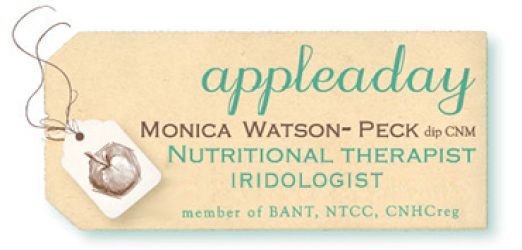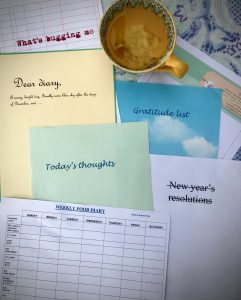This recipe was inspired by Elke’s Austrian take on a Greek spanakopita (spinach pie). Instead of the usual triangle slices of a traditional spanakopita, she opted for the strudel “log” shape, and added loads more delicious spinach than one normally finds in these pies.
I’ve tweaked the recipe yet again by adding more vegetables to the spinach. So it’s no longer a spanakopita but a roasted sweet potato, spinach and leek ‘strudel’! And with a gluten-free puff pastry and dairy-free fetta; a vegan version to see how it works.
Worked a treat!
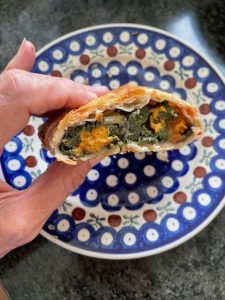
The store-bought ‘Jus-roll’ gluten-free puff pastry makes it all so very easy and quick. And Violife’s vegan Greek fetta is delicious and a great option for anyone going vegan, or with a casein (dairy protein) or lactose intolerance.
You can steam the sweet potato cubes, definitely the healthy option, but as I was roasting a lunch the day before I decided to add the sweet potato cubes to the oven; also the pine nuts right at the end. Less work the following day when I was playing with this recipe.
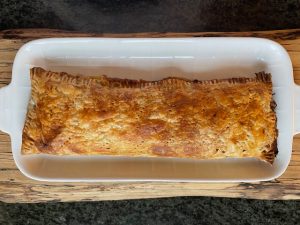
Ingredients:
For six slices
1 packet Jus-roll gluten free puff pastry (or regular Jus-roll puff; or filo.. shortcrust, whatever you like)
400g packet spinach, roughly chopped
green part of one leek, finely sliced
3 cloves garlic, squeezed (two at the start, one added near the end)
1 large sweet potato, about 250g, cubed, then either roasted or steamed before you start your log
dollop of olive oil for a light fry and to lightly brush onto the log before baking
80g toasted pine nuts
100g Violife ‘Greek white’ (or non vegan, regular Greek fetta)
Method:
If you haven’t roasted your pine nuts, nor your cubed sweet potato, do this first. When done put aside where no one will be tempted to have a nibble.
For the filling, pour a couple of tablespoons of olive oil in a pan on a medium heat then add the sliced leek and 2 of the pressed garlic. Gently fry until the leek’s transparent.
Toss in the roughly chopped spinach and wilt. Hover near the pan otherwise your delicious leafy spinach pile will vanish to an overwilted green sludge. The same goes for the pine nuts, keep close, for if you leave the kitchen even for a moment they are bound to burn. Hover. Keep watch.
Add the roasted/steamed sweet potato cubes to the pan of spinach to warm through, then that last garlic clove. Stir in the roasted pine nuts.
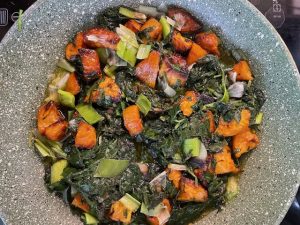
Wait for everything to cool before adding the crumbled fetta.
With ‘Jus-roll’ you can literally unravel it from the box and start filling it with your cooked veg, so easy.
However, if it’s too thick for your taste roll it thinner and larger. Whatever you decide, ensure you have parchment underneath it (the paper it comes wrapped in its box), so you can easily lift the filled roll onto the oven tray.

Spoon the filling along the long side of half the pastry, leaving a clear 2-3 cms edge all around so you can seal it without the filling oozing out. To make your log just fold over the pastry and, with water-wet fingers, press the edges closed then go over them with a fork to create a neater, tighter finish. Brush with oil and prick the pastry, to stop a gap forming inside as it cooks.
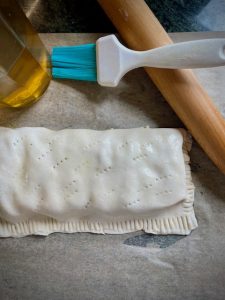
Bake in a moderate fan oven, about 180 C degrees (c350 F), until light golden brown, approx 30 – 45 mins (depending on everyone’s unique oven. Like us, they have personalities and might decide to take longer to colour your strudel).
Slice and serve with a leafy colourful salad, or as part of a delicious summer garden spread.
Kali oreksi! Bon appetit x
